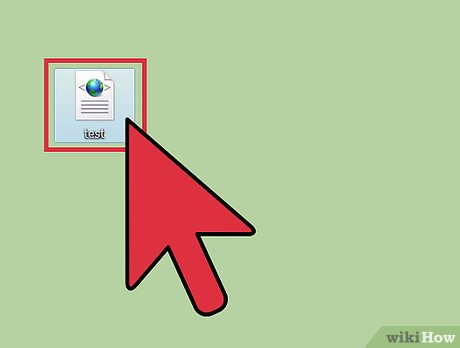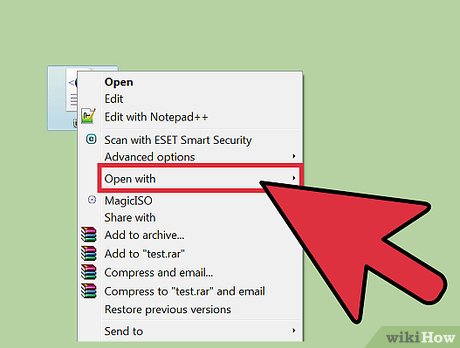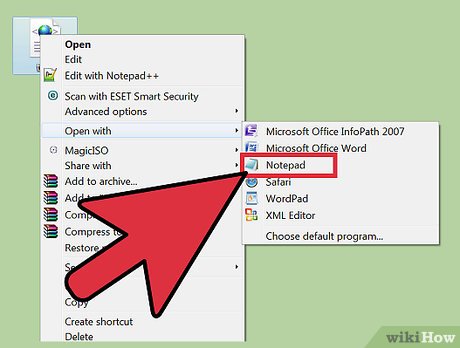How to Open XML
Method 1 of 4:
Using a Text Editor
-
 Find the XML file you want to open. XML files are encoded in plaintext, so you can open them in any text editor and be able to clearly read it.[1]
Find the XML file you want to open. XML files are encoded in plaintext, so you can open them in any text editor and be able to clearly read it.[1] -
 Right-click the XML file and select "Open With." This will display a list of programs to open the file in.
Right-click the XML file and select "Open With." This will display a list of programs to open the file in. -
 Select "Notepad" (Windows) or "TextEdit" (Mac). These are the pre-installed text editors for each operating system, and should already be on the list.
Select "Notepad" (Windows) or "TextEdit" (Mac). These are the pre-installed text editors for each operating system, and should already be on the list.- If they aren't on the list, you'll need to browse for them. Notepad is located at %SystemRoot%system32notepad.exe, and TextEdit can be found in your Applications folder.
- You can use more advanced code editors like Notepad++ or TextMate as well, which can be useful for syntax highlighting and advanced editing. You can still see all of the information using a simple text editor.[2]
-
 Interpret the text on the screen. Your XML file will open in your text editor. The complexity of the file is dependent on what it was created for. Use the tag labels to find the information you are looking for. Generally the labels will be fairly self-explanatory, allowing you to browse through the data and find the information you need.
Interpret the text on the screen. Your XML file will open in your text editor. The complexity of the file is dependent on what it was created for. Use the tag labels to find the information you are looking for. Generally the labels will be fairly self-explanatory, allowing you to browse through the data and find the information you need.- You'll likely see at the top. This indicates that the following content is in XML format.
- XML uses custom tags to house pieces of data. Each of these tags are created for whatever program is using it, so there is no common syntax to the markup labels. For example, one XML file may have a section, and other might have , but both may function similarly.
- Tags can be nested inside other tags, creating a tree. For example, Each tag may have several tags inside, such as and .
Method 2 of 4:
Using a Web Browser
-
 Find the XML file you want to open. While you can use any basic text editor to open an XML file (see above), opening the file in a browser may make it a little easier to navigate. This is because most browsers automatically indent nested tags and allow you to collapse each section of the the XML tree.
Find the XML file you want to open. While you can use any basic text editor to open an XML file (see above), opening the file in a browser may make it a little easier to navigate. This is because most browsers automatically indent nested tags and allow you to collapse each section of the the XML tree. -
 Right-click the file and select "Open With." This will let you choose the program you want to use to open the file.
Right-click the file and select "Open With." This will let you choose the program you want to use to open the file. -
 Select a web browser from the list of programs. You can open the XML file in any web browser. Oftentimes, your web browser will already be on the list of suggested programs. If it isn't, you'll need to browse for it on your computer.
Select a web browser from the list of programs. You can open the XML file in any web browser. Oftentimes, your web browser will already be on the list of suggested programs. If it isn't, you'll need to browse for it on your computer. -
 Read the XML file in your browser. The XML file will open in a new tab in your browser. All of the contents will be displayed, and your browser will automatically indent nested tags. This can make it easier to tell which data belongs to which set.
Read the XML file in your browser. The XML file will open in a new tab in your browser. All of the contents will be displayed, and your browser will automatically indent nested tags. This can make it easier to tell which data belongs to which set. -
 Expand or minimize sections for easier reading. The big advantage to using a browser to read XML files is the ability to control what you see. Click the arrows or +/- buttons next to each section to expand or minimize it.
Expand or minimize sections for easier reading. The big advantage to using a browser to read XML files is the ability to control what you see. Click the arrows or +/- buttons next to each section to expand or minimize it.
Method 3 of 4:
Using Excel
-
 Open Excel. Excel will not usually pop up as a suggested program, so the quickest way to open the file is to open Excel first.
Open Excel. Excel will not usually pop up as a suggested program, so the quickest way to open the file is to open Excel first.- Excel can convert an XML file into a table, which can be useful for visually processing the information.
-
 Click "File" and select "Open." This will display the Open menu.
Click "File" and select "Open." This will display the Open menu. -
 Click the "Browse" button. This will let you look for files on your computer.
Click the "Browse" button. This will let you look for files on your computer. -
 Open the XML file on your computer. You should be able to navigate to it and see it by default, but if you can't, click the "Type" menu and select "XML Files."
Open the XML file on your computer. You should be able to navigate to it and see it by default, but if you can't, click the "Type" menu and select "XML Files." -
 Select "As an XML table." This will convert the XML file into an Excel table.
Select "As an XML table." This will convert the XML file into an Excel table.- You will generally be informed that the XML file does not refer to a schema. Click "OK" to have Excel construct one for you based on the tags in the file.
-
 Read your XML file. Your XML file will be organized into a table based on the tag structure. You can use Excels sorting and filtering tools to customize the table from here.[3]
Read your XML file. Your XML file will be organized into a table based on the tag structure. You can use Excels sorting and filtering tools to customize the table from here.[3]- You may have difficulties rendering complex XML files as tables. If your XML file has lots of nested tags, you may want to use an XML viewer instead.
Method 4 of 4:
Using an XML Viewer
-
 Download an XML viewer program. If you deal with lots of XML files, you may want to get a viewer or XML editor. These can make handling complex XML files much easier. There are a variety of programs available, both free and paid. A popular free, open-source reader is XML Explorer (xmlexplorer.codeplex.com).
Download an XML viewer program. If you deal with lots of XML files, you may want to get a viewer or XML editor. These can make handling complex XML files much easier. There are a variety of programs available, both free and paid. A popular free, open-source reader is XML Explorer (xmlexplorer.codeplex.com).- Different programs will fit different needs. If you need to create a lot XML files, you may want a professional XML editor. These allow you to automate and collaborate on large XML projects.
-
 Open the XML file in your new program. Many XML programs will set themselves as the default program for XML files, allowing you to simply double-click the XML file to open it. If you can't, right-click the XML file and select "Open With." Browse for your newly-installed program.
Open the XML file in your new program. Many XML programs will set themselves as the default program for XML files, allowing you to simply double-click the XML file to open it. If you can't, right-click the XML file and select "Open With." Browse for your newly-installed program. -
 Read your XML. Programs like XML Explorer allow you to collapse sections, as well as turn syntax highlighting on and off. More advanced programs may allow you to make edits and create additional entries.
Read your XML. Programs like XML Explorer allow you to collapse sections, as well as turn syntax highlighting on and off. More advanced programs may allow you to make edits and create additional entries.
4 ★ | 3 Vote
You should read it
- How to Open an EML Format File
- How to Fix JPG file cannot be opened error in Windows 10
- How to View XML Files
- How to open and read the .DAT file?
- What is an AI file How to open an AI file
- What is a .tmp file? How to open .tmp file on Windows computer?
- What file is M4A? How to open, edit and convert M4A files
- How to open, run the .jar file on a Windows computer?
May be interested
- Download OBS - Open Broadcaster Software 26.1
 open broadcaster software is an open source solution for creating and publishing live and recorded content to the internet. download the free open broadcaster software for windows pcs and start streaming today!
open broadcaster software is an open source solution for creating and publishing live and recorded content to the internet. download the free open broadcaster software for windows pcs and start streaming today! - What is open source software?
 open source software (oss) is a software that source code can be viewed and changed by the public.
open source software (oss) is a software that source code can be viewed and changed by the public. - 4 great benefits of using open source software
 there is an open source alternative to almost any proprietary application. it's just a matter of finding it. while we don't exclusively use open source software, many people prefer it to proprietary software for a number of reasons.
there is an open source alternative to almost any proprietary application. it's just a matter of finding it. while we don't exclusively use open source software, many people prefer it to proprietary software for a number of reasons. - 10 best open source web browsers
 you all know about the best mainstream web browsers like chrome, opera, safari, etc. but what about open source browsers? if you like to use open source software, there are many options available to you.
you all know about the best mainstream web browsers like chrome, opera, safari, etc. but what about open source browsers? if you like to use open source software, there are many options available to you. - How to Fix JPG file cannot be opened error in Windows 10
 outdated windows versions, corrupted file systems, or third-party application conflicts may prevent you from opening jpg files.
outdated windows versions, corrupted file systems, or third-party application conflicts may prevent you from opening jpg files. - How to Play MP4s on a Mac
 this wikihow teaches you how to open and view an mp4 file in macos. your mac should usually be able to open most mp4 files by default with quicktime, but if you're having trouble, you should be able to view it in vlc media player. open...
this wikihow teaches you how to open and view an mp4 file in macos. your mac should usually be able to open most mp4 files by default with quicktime, but if you're having trouble, you should be able to view it in vlc media player. open... - 5 ways to open applications in Windows 10
 opening an application on windows 10 is easy if you have pinned the application to the start menu. if not, there is always an apps list - the list of applications in the start menu will allow you to launch most of your applications.
opening an application on windows 10 is easy if you have pinned the application to the start menu. if not, there is always an apps list - the list of applications in the start menu will allow you to launch most of your applications. - Open a slide file in PowerPoint
 introduce how to open a slide file in powerpoint. to open a powerpoint file, do the following: method 1: - open powerpoint - go to file - open tab (or press ctrl + o key combination): 1. open a recently used presentation file - click on recent pr
introduce how to open a slide file in powerpoint. to open a powerpoint file, do the following: method 1: - open powerpoint - go to file - open tab (or press ctrl + o key combination): 1. open a recently used presentation file - click on recent pr - Open WiMAX - telecommunications revolution (Part I)
 ensuring open and coordinated access between manufacturers' devices, open wimax (open wimax) brings the telecommunications market a centralized environment for service operators. with open wimax - the new telecommunications revolution, the benefits of telecom service operators & ocir
ensuring open and coordinated access between manufacturers' devices, open wimax (open wimax) brings the telecommunications market a centralized environment for service operators. with open wimax - the new telecommunications revolution, the benefits of telecom service operators & ocir - How to open the camera on laptop Windows 7/8/10
 to open the camera on your computer, simply enter the camera keyword into the search bar, or use the support software.
to open the camera on your computer, simply enter the camera keyword into the search bar, or use the support software.
























 How to Copy and Paste
How to Copy and Paste How to Make a Zip File
How to Make a Zip File How to Open Downloads
How to Open Downloads How to Sit at a Computer
How to Sit at a Computer How to Filter the Vuvuzela Noise
How to Filter the Vuvuzela Noise